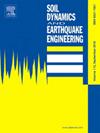阻尼对旧金山湾区软土地震动响应谱坐标的影响
IF 4.2
2区 工程技术
Q1 ENGINEERING, GEOLOGICAL
引用次数: 0
摘要
一个场地的地震危险烈度通常用5%阻尼的伪加速度谱坐标来表征。然而,结构的阻尼比可以低于或高于5%,因此,地震需求可以高于或低于地面运动模型和概率地震危害分析中通常使用的通用值。光谱坐标的调整通常使用修正因子来完成。本研究考察了在旧金山湾区软土上记录的地面运动计算的对应于1%至20%的阻尼比的阻尼修正因子。根据旧金山湾区软土地区348次地面运动记录的数据库计算的313200个比率,进行了一项统计研究。作为统计研究的一部分,提出了一种新的简化方法,基于2%阻尼的伪速度响应谱来获得给定地点的土壤沉积物的主要振动周期。结果表明,阻尼修正因子对土体相对于模态周期的振动周期变化非常敏感。提出了简化方程,以估计阻尼修正因子的均值和对数标准差,以及5%阻尼伪加速度响应谱的对数与阻尼修正因子之间的相关系数作为阻尼水平和由土壤沉积物主导周期归一化的振动周期的函数。本文比较了旧金山湾区软土和墨西哥城软土阻尼修正系数的经验值和建议值。此外,还将本文提出的阻尼修正因子与岩石或坚硬土壤上记录的地面运动所提出的阻尼修正因子进行了比较。本文章由计算机程序翻译,如有差异,请以英文原文为准。
Effect of damping on response spectral ordinates of ground motions recorded on soft soils in the San Francisco Bay Area
The seismic hazard intensity at a site is typically characterized by 5%-damped pseudo-acceleration spectral ordinates. However, structures can have damping ratios lower or higher than 5% damping, and therefore, seismic demands can be higher or lower than those corresponding to this generic value typically used in ground motion models and probabilistic seismic hazard analyses. Adjustment of spectral ordinates is typically done using modification factors. This study examines damping modification factors corresponding to damping ratios ranging from 1% to 20% computed using ground motions recorded on soft soils in the San Francisco Bay Area. A statistical study is conducted based on 313,200 ratios computed using a database of 348 ground motions recorded in the soft soil regions of the San Francisco Bay Area. As part of the statistical study, a new simplified method is proposed to obtain the predominant period of vibration of the soil deposit for a given site based on the 2%-damped pseudo-velocity response spectrum. It is shown that damping modification factors are very sensitive to changes in the period of vibration relative to modal periods of the soil deposit. Simplified equations are proposed to estimate the mean and logarithmic standard deviation damping modification factors as well as the correlation coefficient between the logarithms of the 5%-damped pseudo-acceleration response spectrum and damping modification factors as a function of the level of damping and of the period of vibration normalized by the predominant period of the soil deposit. Comparisons of empirical and proposed damping modification factors are made between those for soft soils in the San Francisco Bay Area and those in Mexico City from prior work conducted by the authors. Additionally, comparisons are presented between the damping modification factors proposed in this work to those proposed from ground motions recorded on rock or firm soil.
求助全文
通过发布文献求助,成功后即可免费获取论文全文。
去求助
来源期刊

Soil Dynamics and Earthquake Engineering
工程技术-地球科学综合
CiteScore
7.50
自引率
15.00%
发文量
446
审稿时长
8 months
期刊介绍:
The journal aims to encourage and enhance the role of mechanics and other disciplines as they relate to earthquake engineering by providing opportunities for the publication of the work of applied mathematicians, engineers and other applied scientists involved in solving problems closely related to the field of earthquake engineering and geotechnical earthquake engineering.
Emphasis is placed on new concepts and techniques, but case histories will also be published if they enhance the presentation and understanding of new technical concepts.
 求助内容:
求助内容: 应助结果提醒方式:
应助结果提醒方式:


